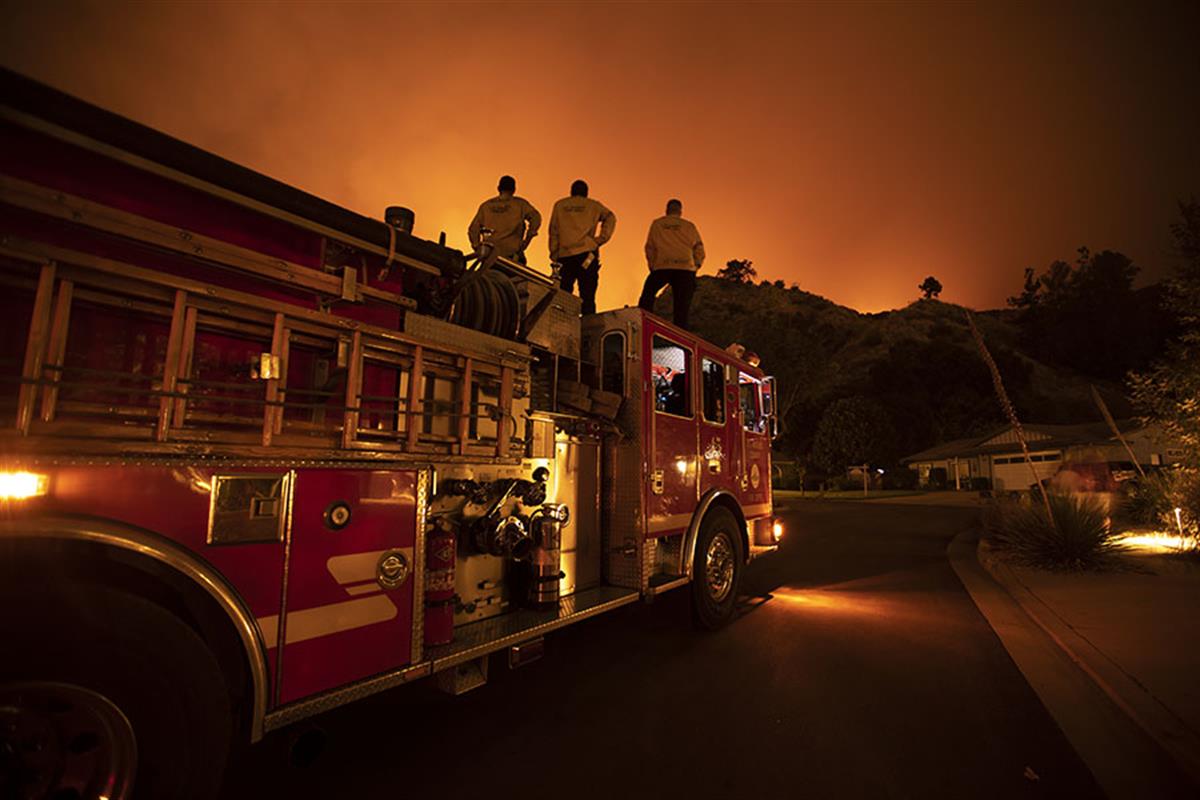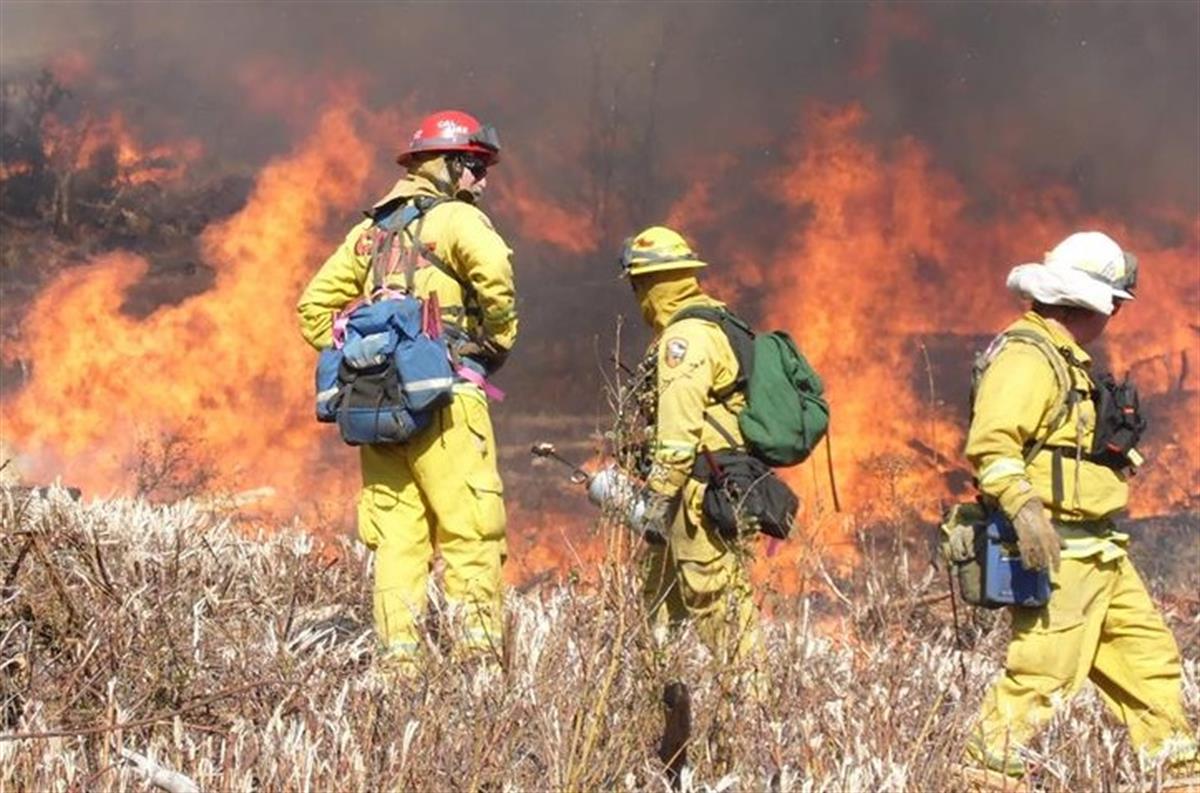Six of the
top 20 largest California wildfires took place in 2020, burning more than
4 million acres. Yet experts predict the 2021 season will be even worse. Learn how campuses across the CSU are contributing to efforts to better understand, predict and manage California’s wildfire crisis.
The CSU’s 23 campuses touch nearly every part of California, and so, unfortunately, does wildfire. As a system that serves the state’s citizens, the university is committed to finding solutions as quickly as possible.
In January 2021, eight CSU campuses came together virtually to host the first-ever CSU wildfire briefing, “Addressing Wildfire and Smoke Impacts in California.” Chico State, Humboldt State, Cal State LA, San Diego State, San José State, Cal Poly San Luis Obispo, CSU San Marcos and Sonoma State each presented a snapshot of their areas of research and academic preparation, followed by a question-and-answer session to discuss some of the state’s most pressing wildfire issues.
“Not only does the CSU have the capacity, but we have the potential to directly address the critical questions in fire science research, education and outreach in the state today,” said San José State University Provost
Vincent Del Casino, Ph.D., who moderated the January briefing. “Simply put, we can change the landscapes of California, and the world, for the better.”
Take a look at some highlights in wildfire research and workforce development from each of the eight campuses.
Chico State | Recovery & Resiliency

A Chico State biology master’s student and land steward at BCCER participates in a prescribed fire on the reserve. Photo by Jason Halley/Chico State
Students at Chico State are immersed in research on wildfire impacts. “Whether assisting faculty to compile the most detailed water quality data set after an urban wildfire in history, or actively participating in fire mitigation projects on over 3,000 acres of wildlands annually, our students yearn to be part of the solution,” said Eli Goodsell, director of the Big Chico Creek Ecological Reserve (BCCER), a 7,835-acre wildland owned by Chico State Enterprises which recently became the largest contiguous ecological reserve in the CSU thanks to a generous land donation.
With thousands of acres of both wild and working lands, Chico State continues to prioritize experiential learning, fire mitigation and post-fire recovery projects. This is exemplified through the recently launched interdisciplinary
master’s degree in wildland management as well as the campus’ recognition and respect for
indigenous wildfire knowledge and practices.
As a result of the devastating
Camp Fire of 2018 and other catastrophic fires in the Butte County region, Chico State established a new staff liaison position for campus community recovery and created the Environmental Resiliency Collaborative (ERC) to bring campus environmental experts together to work on solutions to wildfire impacts and other challenges facing their region.
Humboldt State | World-Class Research

Humboldt State Wildland Fire Lab students examine flammability of hardwood species from as part of an undergraduate research project. Photo by Kellie Jo Brown/Humboldt State
Humboldt State has more than 12 faculty members engaged in research related to wildland fire challenges—publishing more than 100 papers in the last decade, said
Jeffrey Kane, Ph.D., associate professor and director of the university’s
Wildland Fire Laboratory. Areas of research range from wildfire fuels treatment and environmental impacts to incorporating traditional ecological knowledge in wildfire management. Through both private and public partnerships—including tribal governments—HSU’s experts share their world-class research and knowledge to help develop a more fire resilient California.
Cal State LA | Preparing the Fire Protection Workforce
 Cal State LA’s fire protection bachelor’s program prepares students for top positions in firefighting operations.
Cal State LA’s fire protection bachelor’s program prepares students for top positions in firefighting operations.
“Cal State LA’s fire protection administration program arms graduates with technical and administrative skills that lead to some of the top fire protection positions,” said Michael Thomas, Cal State LA assistant professor and retired Los Angeles Fire Department chief.
Typically, fire protection education is limited to lower-division coursework at the community college level. However, Cal State LA’s program is the only one of its kind in California, offering a bachelor’s in
fire protection administration and technology to students who have completed the pre-requisite lower-division courses at the community college level, then transfer to Cal State LA. “Graduates are uniquely prepared to implement the managerial skills that are crucial in commanding large-scale firefighting operations,” Thomas said.
San Diego State | Connecting Wildlands and Communities

SDSU researchers collaborate with the region’s communities to develop climate-smart solutions and resilience strategies. Photo courtesy of SDSU Community Climate Action Network
With $11 million in fire-related funding received over the last five years, San Diego State researchers have engaged in a wide range of studies, including fire mapping and modeling, climate-fire relationships, impacts of fire on wildlife vegetation and water resources, the use of innovative technology and social media to inform emergency management, and much more.
One project that highlights SDSU’s contributions is the
Connecting Wildlands and Communities project, funded by the California State Strategic Growth Council through the California Climate Investments Initiative and is a collaborative effort of the university’s Institute for
Ecological Monitoring and Management (IEMM).
“Together, we’re working to bridge the gap between ecosystem and community resilience planning by assessing climate risks and coordinated strategies to reduce fire risk, promote water sustainability, and protect biodiversity in both our wildlands and communities,” said
Megan Jennings, Ph.D., IEMM director and SDSU assistant adjunct professor.
San José State | State-of-the-Science Modeling

This truck is equipped with the CSU-Mobile Atmospheric Profiling System (CSU-MAPS), which can monitor wildfires and fire weather in remote and mountainous terrain. Photo courtesy of the SJSU Wildfire Interdisciplinary Research Center
“We develop and operate the most advanced fire and smoke prediction system in the U.S. and it’s the same system that’s been adapted all around the world,” said Craig Clements, Ph.D., professor and director of the new
Wildfire Interdisciplinary Research Center at San José State. “We can forecast not only where the fire spreads, but when and where the smoke will go.”
The university also has the only mobile Doppler radar in the western U.S. “We deploy it to active wildfires where we can track smoke in real-time, and it allows us to detect
extreme fire behavior, such as fire tornadoes, leading to increased firefighter safety,” Dr. Clements added.
SJSU offers the only
fire weather-focused graduate degree program in the country, training meteorology students on fire weather forecasting—an emerging need for utility companies in the western U.S. The university also introduced a
wildfire sciences minor for undergraduates starting fall 2021.
Cal Poly San Luis Obispo | Holistic Wildfire Solutions

Dr. Chris Dicus, wildland fuels and fire management professor at Cal Poly San Luis Obispo, shows fire ecology students the recovery of a former wildfire burn area. Photo by Patrick Record/California State University
Cal Poly recently established its
Wildland Urban Interface (WUI) FIRE Institute—a collaboration of 19 of the university’s academic programs along with partner agencies—with the common goal of moving beyond
traditional fire suppression and protection philosophies. The
multidisciplinary institute brings together a cross-section of practitioners in forestry, fire protection, engineering, city and regional planning, architecture, and many others.
“Our approach is both a macro and micro level, from community design to evacuation modeling, from fire engineering to structural hardening, from forest management to home landscaping, from community economics to individual survivability, from air quality to responder health and safety, and from satellite remote sensing to preventing ignitions on the ground,” said
Dan Turner, interim director of the Cal Poly WUI FIRE Institute.
CSU San Marcos | Firefighter Health & Career Development
 CSUSM’s online wildfire science and the urban interface bachelor’s program was developed in partnership with local, state and national fire associations. Photo courtesy of CSU San Marcos
CSUSM’s online wildfire science and the urban interface bachelor’s program was developed in partnership with local, state and national fire associations. Photo courtesy of CSU San Marcos
“Our firefighters are working under some of the most extreme and hazardous conditions known to humans, evidenced by the dramatic incidents of occupational heart attacks and strokes respiratory illness and cancer. The destructive toll on their mental and behavioral health is only now being understood. And that’s where we’ve made a promise to help,” said
Matt E. Rahn, Ph.D., director of the CSU San Marcos
Environmental Leadership Institute.
In response, CSU San Marcos launched a fully
online bachelor’s in wildfire science designed with working fire professionals in mind. The upper-division coursework features a unique curriculum, including topics with a focus on climate change, the recovery of ecological systems and soils post-fire, occupational cancer exposure, and wildfire policy and law. “And it includes the first course in the nation that focuses solely on firefighter mental and behavioral health,” Rahn said.
Page Content
Sonoma State | More Accurate Forest Measurement
 The forest understory grows dense with flammable dead branches and brush—known as “fuel load.” The greater the fuel load, the greater potential for a more severe wildfire, where more carbon can be released into the atmosphere. Lisa Patrick Bentley, Ph.D., assistant professor of biology at Sonoma State, leads an interdisciplinary team focused on quantifying above-ground carbon stocks and fire fuel loads.
The forest understory grows dense with flammable dead branches and brush—known as “fuel load.” The greater the fuel load, the greater potential for a more severe wildfire, where more carbon can be released into the atmosphere. Lisa Patrick Bentley, Ph.D., assistant professor of biology at Sonoma State, leads an interdisciplinary team focused on quantifying above-ground carbon stocks and fire fuel loads.
“Measuring precise dimensions of trees is key to determining how much climate-altering carbon is stored,” Dr. Bentley said. “Fuel loads are difficult to measure, but they need to be accurately quantified to mitigate the severity of wildfires.” Her team uses terrestrial laser-scanning technology and multispectral sensors on drones to assemble detailed 3D data of the forest’s structure. “Graduate student-led research is finding that our methodology can increase the accuracy and cost-effectiveness of forest management.”
Whether on the ground collecting ecological data or on the front lines of a forest fire, the staff, students and alumni of the CSU are meeting the state’s wildfire crisis head-on with leading-edge research and workforce preparation.
“The CSU is passionate about educating the next generation of fire scientists, at both the undergraduate and graduate level. Workforce development—which builds resilience in communities and natural environments—is a key part of the DNA of the CSU,” said SJSU’s Del Casino. “And CSU students are committed to our region and state. They grew up here, they want to give back, they want California to be livable, sustainable and affordable. And the Cal State system prepares them to do just that.”
Learn more about the
CSU’s role in understanding, preventing and fighting California’s devastating wildfires.